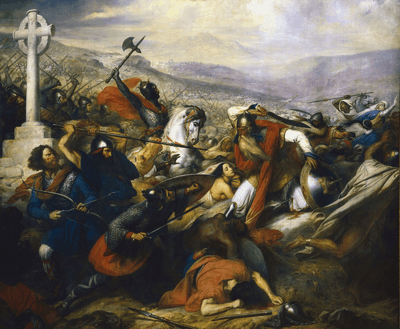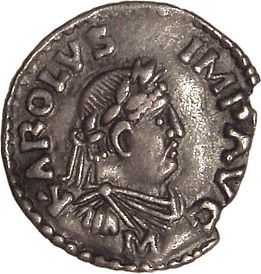Louis IV (10 September 920 – 30 September 954), called d'Outremer or Transmarinus (both meaning "from overseas"), reigned as King of Western Francia from 936 to 954. He was a member of the Carolingian dynasty, the son of Charles III and Eadgifu, a daughter of King Edward the Elder.[1]
Early years across the sea
Louis was only two years old when his father was deposed by his nobles. They set up Robert I in his place. When Louis was three years old, Robert died and was replaced by Rudolph, duke of Burgundy. Rudolph's ally, Count Herbert II of Vermandois, himself a Carolingian, took Charles captive by treachery. The young Louis' mother, Eadgifu, took the boy "over the sea" to the safety of England, hence his nickname. He lived in exile in the household of King Æthelstan.
Return to France
Charles III died in 929, and Rudolph ruled until 936. Upon the death of Rudolph, Louis was summoned back to France with the unanimous support of the nobles. Hugh the Great was especially supportive of his return and probably organized it to prevent Herbert II or Rudolph's brother Hugh the Black from taking the throne. Louis was crowned king at Laon by Artald, Archbishop of Rheims, on Sunday 19 June 936.[2] The chronicler Flodoard records the events as follows:
| Brittones a transmarinis regionibus, Alstani regis praesidio, revertentes terram suam repetunt. Hugo comes trans mare mittit pro accersiendo ad apicem regni suscipiendum Ludowico, Karoli filio, quem rex Alstanus avunculus ipsius, accepto prius jurejurando a Francorum legatis, in Franciam cum quibusdam episcopis et aliis fidelibus suis dirigit, cui Hugo et cetero Francorum proceres obviam profecti, mox navim egresso, in ipsis littoreis harenis apud Bononiam, sese committunt, ut erant utrinque depactum. Indeque ab ipsis Laudunum deductus ac regali benedictione didatus ungitur atque coronatur a domno Artoldo archiepiscopo, praesentibus regni principibus cum episcopis xx et amplius.[3] |
"The Bretons, returning from the lands across the sea with the support of King Athelstan, came back to their country. Duke Hugh sent across the sea to summon Louis, son of Charles, to be received as king, and King Athelstan, his uncle, first taking oaths from the legates of the Franks, sent him to the Frankish kingdom with some of his bishops, and other followers. Hugh and the other nobles of the Franks went to meet him and committed themselves to him[;] immediately he disembarked on the sands of Boulogne, as had been agreed on both sides. From there he was conducted by them to Laon, and, endowed with the royal benediction, he was anointed and crowned by the lord Archbishop Artold, in the presence of the chief men of his kingdom, with 20 bishops."[4] |
Effectively, Louis' sovereignty was limited to the town of Laon and to some places in the north of France; he displayed a keenness beyond his years in obtaining the recognition of his authority by his feuding nobles. Nonetheless, his reign was filled with conflict, in particular with Hugh the Great, count of Paris.
Louis IV fell from his horse and died on 30 September 954 at Rheims, in the Marne, where he is interred at Saint Rémi Basilica.
Ancestry
| Ancestors of Louis IV of France |
|---|
|
|
Marriage and children
In 939, Louis became involved in a struggle with the Holy Roman Emperor Otto the Great on the question of Lorraine, but he then married Otto's sister Gerberga of Saxony (914 – 5 May 984). They were parents to eight children:
Notes
- ↑ Donald A. Bullough, Carolingian Renewal: Sources and Heritage, (Manchester University Press, 1991), 286
- ↑ Pierre Riche, The Carolingians, Transl. Michael Idomir Allen, (University of Pennsylvania Press, 1993), 256.
- ↑ Flodoard, Annales 936, ed. P. Lauer.
- ↑ Dorothy Whitelock (tr.), English Historical Documents c. 500–1042. 2nd ed. London, 1979. p. 344.
- ↑ Burgundy and Provence, 879-1032, Constance Brittain Bourchard, The New Cambridge Medieval History: Volume 3, C.900-c.1024, ed. Rosamond McKitterick and Timothy Reuter, (Cambridge University Press, 1999), 342.
References
- Flodoard, Annales, ed. Philippe Lauer, Les Annales de Flodoard. Collection des textes pour servir à l'étude et à l'enseignement de l'histoire 39. Paris: Picard, 1905.
|
|---|
| - Legend: → ≡ "father of",
- * ≡ "brother of"
, the daughter of Pepin I, married Ansegisel, the son of Arnulf of Metz, and was the mother of Pepin II. | | | Pippinids | |
|---|
| | Arnulfings | |
|---|
| | Early Carolingians | Sons of Charles Martel | | | Carloman, son | | |
|---|
| | Pepin III, sons | |
|---|
| | Bernard, sons | |
|---|
|
|---|
| | Carolingian Empire | |
|---|
| | West Francia | |
|---|
|




